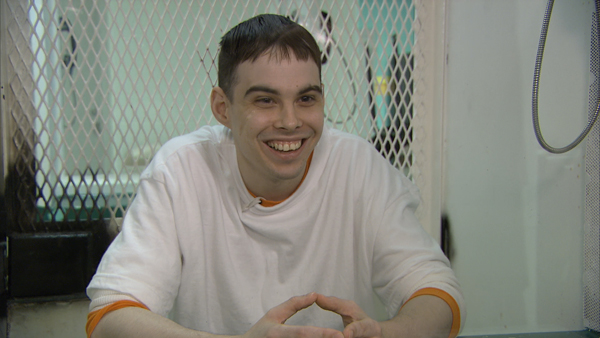
Michael James Perry interviewed in INTO THE ABYSS (Photo: CDTV/Sundance Selects)
Directed by Werner Herzog
Produced by Erik Nelson
Released by Sundance Selects
USA. 106 min. Not rated
With Into the Abyss, director Werner Herzog takes a startlingly clear-eyed look at crime and capital punishment in Texas. His subtitle, “A Tale of Death, A Tale of Life,” emphasizes how he edits a series of frank interviews with a broad array of individuals into a compelling story. His opening interview with the childish 28-year-old Michael James Perry in prison was conducted eight days before his scheduled execution last year.
Part one is “The Crime,” told through the dry law enforcement parlance of a police lieutenant. At first, it seems like gruesome TV magazine coverage (this film was originally conceived for the Investigation Discovery channel). Going to the scenes of the crimes in 2001 and their aftermath, the camera travels from a big house in a suburban gated community, 40 miles north of Houston, to a wooded lake, and back and forth, as a very long night of dead bodies and stolen cars is described. Lisa Stotler-Balloun recalls the confusion as she learned about the deaths of her mother and brother before holding up their smiling photographs, and a cop notes that there were no clues until two drunk nineteen year olds bragged how they got expensive cars. That led the police on a violent chase and then to the hidden bodies.
Herzog doesn’t dwell on the legal niceties of whether Perry’s confession was coerced, as his lawyers later claimed, or on other legal issues of his appeals. Rather, “Part 2: The Dark Side of Conroe, Texas,” gives a full picture of the grim lives of the two young men that led them across the tracks that night. (All the interviewees are white with deep Texan drawls, but the class issues resonate.) The image of Perry as a smiling man-boy on death row is rounded out by descriptions of him as a runaway with behavior problems, who led a marginal, homeless existence of petty crimes before latching onto Jason Aaron Burkett. While Perry, crucially, had no one to stick up for him in court, Burkett has the belated support of rough and tough tattooed family members and friends, who manage a hardscrabble life of occasional work with cars and in construction between bar fights and run-ins with the law. Herzog focuses on the sentencing, parsing how the two defendants—who each at various times gave different, self-serving accounts of who shot which victim—ended up with different sentences, Perry with death and Burkett with life in prison.
In “Part 3: Time and Emptiness,” a moving sequence of interviews highlights the human arbitrariness of how the system selects life or death. Burkett’s brother breaks his out-of-state parole to visit him in jail, while their father, also interviewed in prison, tells Herzog of his own five terms in jail, with the current sentence keeping him inside for 40 years. The Burkett patriarch earnestly describes that he was able to successfully plead with the jury not to punish his son for his bad parenting, and he is sure he elicited tears to spare Jason’s life. In “Part 4: A Glimmer of Hope,” Jason Burkett benefits from another advocate, a figure becoming familiar in this documentary genre, the woman whose correspondence develops into a romance with the incarcerated man. (Herzog raises the issue with her if she’s like a “death row groupie,” and the viewer has to ponder her pregnancy.)
From sociology, Herzog moves on, in “Part 5: The Protocol of Death,” to the practicality of implementing capital punishment and the psychological toll it takes on the participants in the prison bureaucracy, accompanied by a depressing view of the extensive prison cemetery—Perry was the 461st murderer executed in Texas since 1976. A screening of The Chair, filmed by Richard Leacock, D. A. Pennebaker, and others in 1962, at this film’s New York premiere during the recent DOC NYC 2011 Festival, showed that other than the change from the electric chair to lethal injection, not much has changed for those involved in these cases.
Upfront from the start, Herzog says he’s against capital punishment, and in the “Epilogue: The Urgency of Life,” he probes the feelings of victims’ family members, several of whom witnessed Perry’s execution, whether justice—or retribution—would be served without death. But he is not crusading to prove an individual’s innocence, as in recent advocacy documentaries (the “Paradise Lost” trilogy; Incendiary: The Willingham Case; Crime After Crime.) While his German accent positions him in the interviews as not only an outsider but as a foreigner whose country carried out the death penalty to extremes, he just seeks to shine a light on the facts for the viewer to soberly decide.
















Leave A Comment